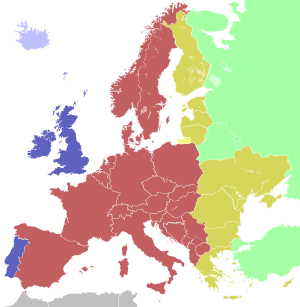
Back Gekoördineerde Universele Tyd Afrikaans UTC ALS Tiempo Universal Coordinau AN توقيت عالمي منسق Arabic Tiempu Coordináu Universal AST UTC AV Ümumdünya vaxtı Azerbaijani دونیانین ایستاندارد زامانی AZB Galah Universal Kakoordinasi BAN Koordiniade Wejdzeid BAR

| blå | Vesteuropæisk tid (UTC+0) Vesteuropæisk sommertid (UTC+1) |
| lyseblå | Vesteuropæisk tid (UTC+0) |
| rød | Centraleuropæisk tid (UTC+1) Centraleuropæisk sommertid (UTC+2) |
| kaki | Østeuropæisk tid (UTC+2) Østeuropæisk sommertid (UTC+3) |
| gul | Østeuropæisk tid, Kaliningradtid, (UTC+2) |
| grøn | Moskva-tid (UTC+3) |
Koordineret universaltid (fransk: temps universel coordonné, UTC) er Verdens primære internationale tidsstandard til brug for regulering af ure og klokkeslæt.[1][2] Koordineret universaltid kaldes på dansk også universel tid eller undertiden verdenstid. Tidsstandarden er for de fleste anvendelser det samme som Greenwich Mean Time (GMT), men GMT er ikke længere præcist defineret af videnskaben.
De forskellige tidszoners afvigelse fra UTC angives som UTC efterfulgt af et plustegn eller minustegn og et tal (UTC−12 til UTC+14). Standardtiden UTC angives typisk som UTC+0. I Danmark er der indført centraleuropæisk tid, og tiden angives som UTC+1 ved normaltid og som UTC+2 ved sommertid.
- ^ timeanddate.com: UTC – The World's Time Standard Citat: "...UTC is the time standard commonly used across the world. The world's timing centers have agreed to keep their time scales closely synchronized - or coordinated - therefore the name Coordinated Universal Time...", backup
- ^ copradar.com: Coordinated Universal Time Citat: "...Mean solar time -- a measurement of the Earth's rotation with respect to the 'fictitious' mean sun...second -- One second (1 s or 1 sec.) is the duration of 9,192,631,770 periods of radiation corresponding to the transition between the two hyperfine levels of the ground state of the cesium 133 atom (Cs)...UT1 -- UT0 corrected for polar motion (widely used)...UTC -- civil atomic time scale on or about the Greenwich meridian kept within 0.9 seconds of UT1...", backup